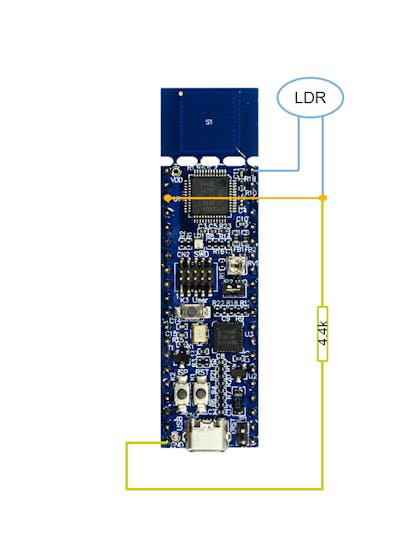- NXP Forums
- Product Forums
- General Purpose MicrocontrollersGeneral Purpose Microcontrollers
- i.MX Forumsi.MX Forums
- QorIQ Processing PlatformsQorIQ Processing Platforms
- Identification and SecurityIdentification and Security
- Power ManagementPower Management
- MCX Microcontrollers
- S32G
- S32K
- S32V
- MPC5xxx
- Other NXP Products
- Wireless Connectivity
- S12 / MagniV Microcontrollers
- Powertrain and Electrification Analog Drivers
- Sensors
- Vybrid Processors
- Digital Signal Controllers
- 8-bit Microcontrollers
- ColdFire/68K Microcontrollers and Processors
- PowerQUICC Processors
- OSBDM and TBDML
-
- Solution Forums
- Software Forums
- MCUXpresso Software and ToolsMCUXpresso Software and Tools
- CodeWarriorCodeWarrior
- MQX Software SolutionsMQX Software Solutions
- Model-Based Design Toolbox (MBDT)Model-Based Design Toolbox (MBDT)
- FreeMASTER
- eIQ Machine Learning Software
- Embedded Software and Tools Clinic
- S32 SDK
- S32 Design Studio
- Vigiles
- GUI Guider
- Zephyr Project
- Voice Technology
- Application Software Packs
- Secure Provisioning SDK (SPSDK)
- Processor Expert Software
-
- Topics
- Mobile Robotics - Drones and RoversMobile Robotics - Drones and Rovers
- NXP Training ContentNXP Training Content
- University ProgramsUniversity Programs
- Rapid IoT
- NXP Designs
- SafeAssure-Community
- OSS Security & Maintenance
- Using Our Community
-
-
Light intensity measurement using the new LPC845 Breakout Board
Turn on suggestions
Auto-suggest helps you quickly narrow down your search results by suggesting possible matches as you type.
Light intensity measurement using the new LPC845 Breakout Board
- Subscribe to RSS Feed
- Mark as New
- Mark as Read
- Bookmark
- Subscribe
- Printer Friendly Page
- Report Inappropriate Content
01-14-2019
01:00 AM
Using SDK drivers for LPC845 Breakout Board, this project measures the ambient light intensity by using LDR (Light Dependent Resistor). The voltage values from LDR are read through an ADC. The new LPC845 Breakout board has an SDK support which makes it a lot easier to interface an LDR for measuring light intensity compared to the conventional coding style. I have used the MCUXpresso IDE for modifying the pins and clock configuration settings.
The project requires a resistor and LDR (Light Dependent Resistor)/Photoresistor in a resistor divider circuit as shown below:

The value of R1 here is 4.4Kohm.
The output of this resistor divider circuit is connected to the assigned ADC channel. In this application, I have assigned it to the ADC0_8 channel which is the PIO0_18 (pin 3) and configured it accordingly in the software.
Components used: LPC845 Breakout Board, Light Dependent Resistor(LDR)/Photoresistor, 2.2Kohm resistor (Quantity:2)
LPC845 Breakout Board connections to the LDR are as shown:
| LPC845 | LDR | |
|---|---|---|
| Pin Name | Board Location | Pin Name |
| ADC_8 | PIO0_18 (CN1-3) | resistor divider o/p |
| VCC | CN1-40 | LDR |
| GND | CN1-20 | 4.4k resistor |

For this application, I have used ADC0_8 as the ADC channel which converts the LDR output analog voltage values to digital values. The values printed on the console window reflect the change in the light intensity.
(For testing purposes, the light intensity can be changed by covering the LDR or using a cellphone flash)
The LPC845 Breakout board has an SDK package support. I used the ADC SDK driver API in the software for interfacing the hardware components. The MCUXpresso SDK Builder has open source drivers, middleware, and reference example applications for software development. Customize and download the SDK specific to the processor and then import the zip file to the project in MCUXpresso IDE.
The LPC845 Breakout board also features function-configurable I/O ports through a switch matrix (SWM). This makes it easier to configure pin routing and other pin electrical features. The configuration tool which is integrated into the IDE is useful for making changes in the switch matrix. The source code is auto-generated when the pin configuration or peripherals are changed.
/* ADC_CHN8 connect to P0_18 */
SWM_SetFixedPinSelect(SWM0, kSWM_ADC_CHN8, true);
The source code for this application and board info for the LPC845 Breakout board can be found here.
int main(void)
{
/* Initialize board hardware. */
BOARD_InitPins();
BOARD_BootClockRUN();
BOARD_InitDebugConsole();
/* Configure the converter and work mode. */
ADC_Configuration();
while(1)
{
/* Trigger the sequence's conversion by software */
ADC_DoSoftwareTriggerConvSeqA(DEMO_ADC_BASE);
/* Wait for the converter to be done. */
while (!ADC_GetChannelConversionResult(DEMO_ADC_BASE, DEMO_ADC_SAMPLE_CHANNEL_NUMBER, &adcResultInfoStruct))
{
}
/* Display the conversion result */
PRINTF("adcResult = %d\r\n", adcResultInfoStruct.result);
}
}
nxp mcu tools lpcbreakout sdk builder mcuxpresso 10.2
Labels
You must be a registered user to add a comment. If you've already registered, sign in. Otherwise, register and sign in.
Labels
-
101
6 -
communication standards
4 -
General Purpose Microcontrollers
19 -
i.MX RT Processors
45 -
i.MX Processors
43 -
introduction
9 -
LPC Microcontrollers
73 -
MCUXpresso
32 -
MCUXpresso Secure Provisioning Tool
1 -
MCUXpresso Conig Tools
30 -
MCUXpresso IDE
40 -
MCUXpresso SDK
25 -
Model-Based Design Toolbox
6 -
MQX Software Solutions
2 -
QorIQ Processing Platforms
1 -
QorIQ Devices
5 -
S32N Processors
4 -
S32Z|E Processors
6 -
SW | Downloads
4
- « Previous
- Next »